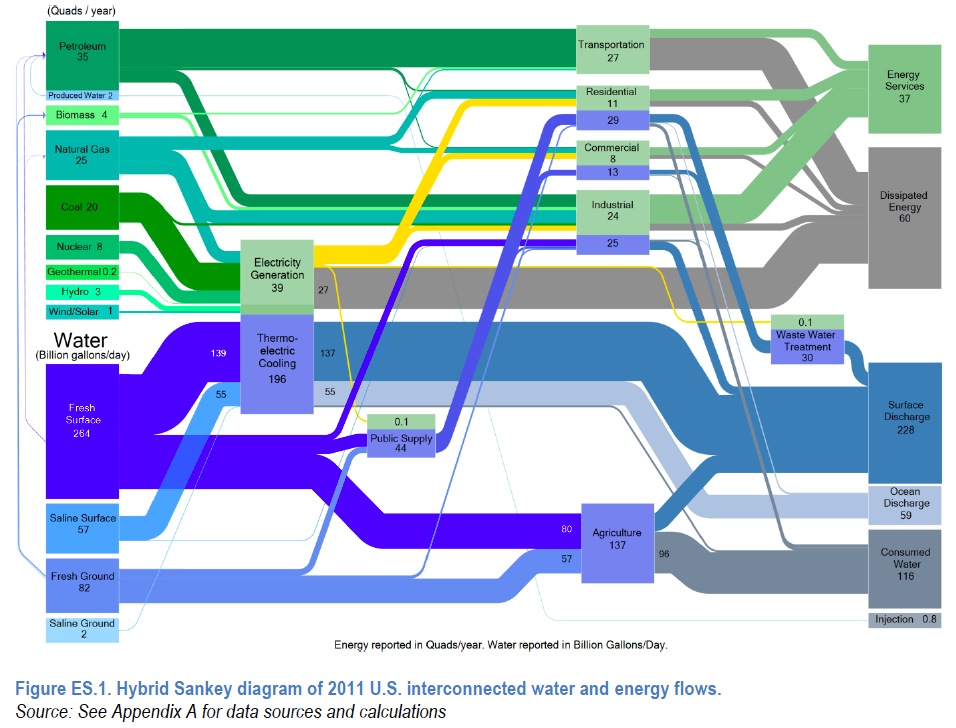UNITED STATES DEPARTMENT OF ENERGY
Executive Summary
Present day water and energy systems are tightly intertwined. Water is used in all phases of energy production and electricity generation. Energy is required to extract, convey, and deliver water of appropriate quality for diverse human uses, and then again to treat wastewaters prior to their return to the environment. Historically, interactions between energy and water have been considered on a regional or technology-by-technology basis. At the national and international levels, energy and water systems have been developed, managed, and regulated independently.
Recent developments have focused national attention on the connections between water and energy infrastructure. For example, when severe drought affected more than a third of the United States in 2012, limited water availability constrained the operation of some power plants and other energy production activities. Hurricane Sandy demonstrated that vital water infrastructure can be impaired when it loses power. The recent boom in domestic unconventional oil and gas development brought on by hydraulic fracturing and horizontal drilling has added complexity to the national dialogue about the relationship between energy and water resources.
Several current trends are further increasing the urgency to address the water-energy nexus in an integrated and proactive way. First, climate change has already begun to affect precipitation and temperature patterns across the United States. Second, U.S. population growth and regional migration trends indicate that the population in arid areas such as the Southwest is likely to continue to increase, further complicating the management of both energy and water systems. Third, introduction of new technologies in the energy and the water domains could shift water and energy demands. Finally, developments in policies addressing water rights and water impacts of energy production are introducing additional incentives and challenges for decision making.
These trends may present challenges, but they also present opportunities. An integrated, strategic approach can guide technology research and development (R&D) to address regional water-energy issues and also have impact at the national and global scale. Enhancing and integrating data and models will better inform researchers, decision makers, and the public.
This nexus report frames an integrated challenge and opportunity space around the water-energy nexus. It explains and strengthens the logical structure underpinning the Department of Energy (DOE)‘s long-standing technology and modeling R&D, and lays the foundation for potential future efforts. The report is also intended as an invitation for collaboration to DOE‘s many current and potential partners in the water-energy arena. Many other federal agencies also have important roles and activities at the water-energy nexus, as do regional, state, tribal, and local authorities. Other important organizations include private companies, national non-governmental organizations (NGOs), international governments, universities, and municipal facilities.
Activities discussed in this report are subject to future evaluation to determine the priority, appropriate agency (private, state, local, or federal) and appropriate share of any cost or responsibilities. Many federal agencies have missions related to topics and activities discussed in this report and if adopted in future budgets, such activities could reside at federal agencies other than DOE.
Download full version (PDF): The Water-Energy Nexus
About the United States Department of Energy
www.energy.gov
“The mission of the Energy Department is to ensure America’s security and prosperity by addressing its energy, environmental and nuclear challenges through transformative science and technology solutions.” – See more at: https://www.infrastructureusa.org/offshore-wind-market-and-economic-analysis/#sthash.K7FEIqyI.dpuf







 RSS Feed
RSS Feed